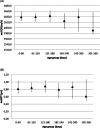Quantitative ultrasound applied to metacarpal bone in infants
- PMID: 24010019
- PMCID: PMC3757467
- DOI: 10.7717/peerj.141
Quantitative ultrasound applied to metacarpal bone in infants
Abstract
Aim. To provide bone status assessment in infancy using quantitative ultrasound (QUS) applied to second metacarpus. Methods. 103 healthy term infants and 3 patients with rickets, aged ≤ 12 months, underwent metacarpal QUS evaluation using QUS DBM Sonic Aurora IGEA (MO, Italy), which measures speed of sound (mcSOS) and bone transmission time (mcBTT). Results. In the total sample, median (interquartile range) of mcSOS was 1640.00 (26.0) m/s and mcBTT 0.82 (0.21) µs. Moreover, reference values for age were obtained based on estimation of the lower and upper percentiles. We observed a statistical significant difference between groups of age for mcSOS (p = 0.016). In a multiple linear regression model, we found a relation between age at enrolment and mcSOS (β = -0.608; p = 0.000) and mcBTT (β = -0.819; p = 0.001). A positive correlation between mcSOS and mcBTT has been observed (r = 0.631; p = 0.000). All the patients with rickets showed values of mcSOS and mcBTT lower than the 10th percentile. Conclusion. Our findings show that this new simple technique appears to be a promising tool for monitoring bone mineral status in pediatric clinical practice and in early life. Furthermore, it could be considered a useful method to investigate and to monitor the role of different factors on programming of bone health and it should be tested as a new method for monitoring subjects with rickets during therapy.
Keywords: Bone mineral status; Infants; Quantitative ultrasound; Reference values; Rickets; Second metacarpus.
Figures
Similar articles
-
Is quantitative ultrasound a measure for metabolic bone disease in preterm-born infants? A prospective subcohort study.Eur J Pediatr. 2021 Sep;180(9):3009-3017. doi: 10.1007/s00431-021-04081-4. Epub 2021 Apr 22. Eur J Pediatr. 2021. PMID: 33890155 Free PMC article.
-
Bone mineral status in breast-fed infants: influence of vitamin D supplementation.Eur J Clin Nutr. 2011 Mar;65(3):335-9. doi: 10.1038/ejcn.2010.274. Epub 2011 Jan 12. Eur J Clin Nutr. 2011. PMID: 21224865
-
Assessment of skeletal development in preterm and term infants by quantitative ultrasound.Pediatr Res. 2005 Aug;58(2):341-6. doi: 10.1203/01.PDR.0000169996.25179.EC. Epub 2005 Jul 8. Pediatr Res. 2005. PMID: 16006425
-
Is vitamin D supplementation necessary in healthy full-term breastfed infants? A follow-up study of bone mineralization in healthy full-term infants with and without supplemental vitamin D.Minerva Pediatr. 2013 Jun;65(3):253-60. Minerva Pediatr. 2013. PMID: 23685376
-
The role of quantitative ultrasound in the assessment of bone: a review.Clin Physiol. 1998 Jan;18(1):3-17. doi: 10.1046/j.1365-2281.1998.00067.x. Clin Physiol. 1998. PMID: 9545615 Review.
Cited by
-
Clinical Devices for Bone Assessment.Adv Exp Med Biol. 2022;1364:35-53. doi: 10.1007/978-3-030-91979-5_3. Adv Exp Med Biol. 2022. PMID: 35508870 Review.
-
Feasibility of quantitative ultrasonography for the detection of metabolic bone disease in preterm infants - systematic review.Pediatr Radiol. 2018 Oct;48(11):1537-1549. doi: 10.1007/s00247-018-4161-5. Epub 2018 Jun 16. Pediatr Radiol. 2018. PMID: 29907939 Free PMC article.
-
Vitamin D in pediatric age: consensus of the Italian Pediatric Society and the Italian Society of Preventive and Social Pediatrics, jointly with the Italian Federation of Pediatricians.Ital J Pediatr. 2018 May 8;44(1):51. doi: 10.1186/s13052-018-0488-7. Ital J Pediatr. 2018. PMID: 29739471 Free PMC article. Review.
References
-
- Ahmad I, Nemet D, Eliakim A, Koeppel R, Grochow D, Coussens M, Gallitto S, Rich J, Pontello A, Leu S-Y, Cooper DM, Waffarn F. Body composition and its components in preterm and term newborns: a cross-sectional, multimodal investigation. American Journal of Human Biology. 2010;22:69–75. doi: 10.1002/ajhb.20955. - DOI - PMC - PubMed
-
- Baroncelli GI, Federico G, Bertelloni S, Sodini F, De Terlizzi F, Cadossi R, Saggese G. Assessment of bone quality by quantitative ultrasound of proximal phalanges of the hand and fracture rate in children and adolescents with bone and mineral disorders. Pediatric Research. 2003;54:125–136. doi: 10.1203/01.PDR.0000069845.27657.EB. - DOI - PubMed
-
- Baroncelli GI, Federico G, Vignolo M, Valerio G, del Puente A, Maghnie M, Baserga M, Farello G, Saggese G, Phalangeal Quantitative Ultrasound Group Cross-sectional reference data for phalangeal quantitative ultrasound from early childhood to young-adulthood according to gender, age, skeletal growth, and pubertal development. Bone. 2006;39:159–173. doi: 10.1016/j.bone.2005.12.010. - DOI - PubMed
-
- Brown KH. WHO/UNICEF review on complementary feeding and suggestions for future research: WHO/UNICEF guidelines on complementary feeding. Pediatrics. 2000;106:1290–1291. - PubMed
LinkOut - more resources
Full Text Sources
Other Literature Sources



